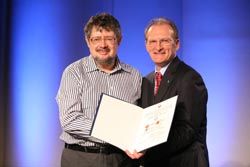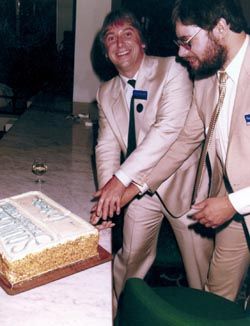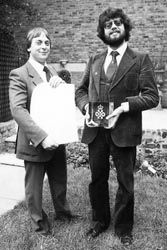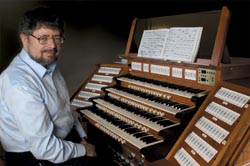In the late '80s, while still with Soundcraft, Blyth returned to his musical studies on both piano and organ, gaining performance diplomas from the Royal College of Organists, Royal College of Music, and Trinity College of Music, culminating in a piano recital at London's Whitfield Street Studio to celebrate his 40th birthday and an organ recital at St. Thomas Church on Fifth Avenue in New York City to celebrate Soundcraft's 21st year. These organ recitals are now a staple of the AES schedule.NAME: Graham Blyth
COMPANY: Soundcraft
TITLE: Technical Director
BACKGROUND: Since his university days, when he founded the Student Music Society while studying electrical engineering, Blyth has found a balance between technology and music. An accomplished organist, Blyth today divides his time between his work at Soundcraft, various musical pursuits, and the design of digital organs.
SCN: Some would say that the business of sound grew up around the Soundcraft Series 1 mixer, as its popularity triggered the launch of numerous rental companies, and its highly musical characteristics helped establish the "British Sound". How would you describe the connection between your musical studies and your work with Soundcraft?

At the Opening Ceremonies of the 123rd AES Convention in New York this year, Soundcraft technical director and co-founder Graham Blyth (left) was presented with the prestigious Fellowship Award by AES President Wieslaw Woszczyk.
If anyone has a Series One out there, remove the front panel from the flight case and look at the wires from the power inlet to the circuit boards. If it's a five-way plait, then it was built by a Dink. My degree was in electrical engineering, about which I remember little except the maths, and we also learned some rudimentary electronics.
All my early designs were heavily influenced by my mentor, the late, great Bill
Kelsey, and I spent a lot of time just fiddling, making useful improvements to his work.
To answer the question more directly, I would say that the brain activities required to play complex music improve your cognitive and creative processes all 'round, but I've also always had an enquiring mind, constantly asking "what if" and "why not".
SCN: Much has changed in the 37 years that you have been designing consoles, but one of your core considerations has always been the intuitive nature of their operation. What factors play into this aspect of your designs?

Celebrating their 10-year-anniversary in 1983.
There were certain truths that I've always held to be self evident and come from my time at Kelsey and Morris: Gain is Red, Sends are Green or Blue, and Pan is Yellow (though certain of our marketing people have used pastel versions of these colors!), and the module layout follows the signal path down the module. Though some designers took another view, most analog mixers today still conform to this scheme, and it doesn't really matter whether it was right or wrong anymore, the point is that a user can walk up to most consoles in the world and be mixing with them almost immediately.
SCN: Your organ playing has led you to become involved in the design of digital organs, and your appreciation for music is exemplified in your roles as artistic director of Chamber Concerts and director of the Festival of Arts in your hometown of Wantage, Oxfordshire. Furthermore, in 1996, you built an 80-seat recital hall attached to your house using the Lexicon Lares acoustics enhancement system. Can you attempt to quantify the effect that technology has had on musical enjoyment?
GB: I think it's a very mixed story and I'll give two examples. Last time he was over here, I was invited to a Stevie Wonder concert at the Royal Albert Hall in London. For those that don't know, this hall is a vast open space, but now has a large quantity of what look like flying saucers hanging between the roof and the auditorium. The concert was an aural nightmare simply because the front of house engineer had the band, particularly the massive percussion section, up so loud before Stevie even came on that there was no room for him in the mix once he did. The PA was massive, and there had to be in the order of 96 channels of mixer (analog back then) out front and the whole processing rack was red lining all the time. This was incredibly frustrating for me as I was close enough to reach out and pull down the drum VCA by about 3/8-inch, and that was all that was needed. At the rear of the stage was a 30-piece string orchestra of London's finest and we hardly heard them.

- Blyth and his Soundcraft co-founder Phil Dudderidge achieved many milestones early in the company's history. They received two Queen's Awards.ms like 150 years, and we're at the Albert Hall again (pre-dating the flying saucers), this time I'm assisting King Crimson's Peter Sinfied at a 20-channel Kelsey mixer, with just a pair of RCA "W" bins on stage with two pairs of Vitavox S3's horns for the top. All this was powered by four Quad303 hi-fi power amps. The result was like listening to a big warm hi-fi system, because Peter knew rule number one, which is "Get the vocal out there", and everything else follows from that.
- Generally, however, the answer has to be Yes, technology has been the driving influence behind much musical expression (though not always to my personal taste) and the enabler for almost all musical creativity. The existence of MP3, in spite of its obvious failings, has got to be the most significant piece of technology since the CD and has introduced the work of often unknown musicians into the huge youth culture, and therefore bought some true geniuses into the public domain.
- Without David Griesinger's LARES system my life would not be such fun because the Challow Park Recital Hall would not have worked. LARES gives us the ability to create any size of acoustic, from a Cathedral for an Organ Recital down to an intimate chamber music room for a String Quartet, and maintain it whatever the size of audience. Apart from being the ultimate toy for any musician (not forgetting the Fazioli Piano, Veritas Organ and Horniblow Harpsichord as well), the Hall has bought much wonderful music to many people either through our regular live concerts but also through the many CDs recorded there.
Soundcraft spread its reach across the Atlantic with the help of Soundcraft U.S. in southern California and Soundcraft Canada. Pictured here are various members of the North American distribution team: (top row l-r) Soundcraft Canada's Richard Lasnier and Betty Bennett from the SoCal office (now CEO of Apogee); (bottom row l-r), Jean Daoust, principal of Soundcraft Canada, Blyth, Dudderidge, and Wayne Freeman (now sales director for Marsall Electronics).
SCN: In addition to your recent AES Fellowship, you were also elected as a Fellow of the Royal Society of Arts in 2006. What is your advice to others who want to continue to cultivate the musical interests that brought them to the pro audio industry?
GB: Keep playing and keep practicing. When I was a kid, I played all the time but never really practiced. The result was that I chose to go the Science rather than Arts route at University. It wasn't 'til I was 38, with Soundcraft well established, that I went back into serious study and, in particular, learned how to practice properly. I want to say to all keyboard players out there, whatever your style, you know that half-speed dotted rhythm practice regime you hear about? Well, it really works, so stop reading this and go and do some now and remember that Rachmaninoff practiced v e r y s l o w l y indeed!
SCN: How would you finish the following sentences?
From a musician's point of view, the audio industry is...the oil that keeps the creative engine running.
From a technical director's point of view, musicians are...unfortunately largely invisible to me in my work. I deal mostly with Sound Engineers, but most of them are or were musicians, and almost all the staff at Soundcraft involved in product development and many on the design side are musicians so there's no shortage of informed input to the design process.
Designs initiated on cocktail napkins...tend to be as blurred as the ink on the napkin, but they often prompt a thought process that ends up becoming part of a product. Of course, alcohol tends to be involved as well, and the napkin often gets left behind in the blur of the evening, but the thought generally seems to survive.
Analog consoles are to digital consoles what...vinyl is to the CD. That is, of course, the obvious completion of the sentence, but I think it is true enough. While there are people who definitely prefer Vinyl to CDs, for the vast majority of us, a well-mastered CD of fine music is just as enjoyable as the same on vinyl. Emotionally, I'd rather hear the whole of Mahler 3 as a continuous piece of music on CD than the very best LP version, and have to get up to turn over the record.
As regards analog versus digital consoles from a sound quality point of view, best in class analog product these days is truly excellent, but so is digital. The companies that take great care over their analog stages, use the best internal digital format and write the best DSP code end up with the best sounding product. Even the least esoteric of the Golden Ear Brigade can hear the differences.










